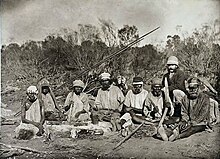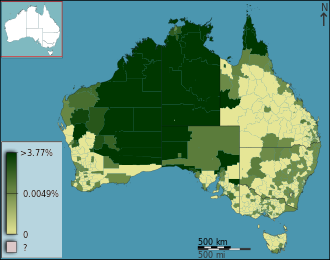Paakantyi
| Paakantyi Lands New South Wales |
|---|
The Paakantyi (Barkindji) are an Australian Aboriginal tribal group of the Darling River basin in Far West New South Wales, Australia.
Traditional Country

The homelands of the Paakantyi extended from what is now Wentworth in the Riverina Bioregion, northward through the Murray Darling Depression Bioregion and into the Darling Riverine Plains Bioregion beyond Wilcannia to Bourke.[2] They lived also in the back country from the river, around the Paroo River and Broken Hill.[3]
In the nineteenth century they were much reduced by disease and they ended up working for the immigrants who had invaded their lands. Pictures were taken by Frederic Bonney at Momba Station in the 1870s which have provided a sympathetic and accurate picture of these people. Unusually Bonney records their names and his 'reverence' for their integrity.[1]
Paakantyi Language

Traditionally they speak the Paakantyi language, which is part of the Pama–Nyungan languages Sprachbund, and one of the three major Aboriginal language groups for the Aboriginal people of present-day Broken Hill Region.
The name of the language refers to the Paaka (Darling River),[2] with the suffix -ntyi, meaning 'belonging to'. The name Paakantyi therefore simply means the River People.
Etymologically the suffix -kali has been attributed as meaning 'people', and is incorporated in numerous group names in the nearby area, including Pantyikali (Creek people), Bulali (Hill people) and Thangkakali.[4]
The major work on the Paakantyi language has been that of linguist Luise Hercus.[5]
See also
References
- ^ a b printers draft, retrieved 24 June 2014
- ^ a b National Indigenous Land and Sea Management Conference 2010.
- ^ Luise Hercus. Baagandji Grammar, ANU 1960; Paakantyi Dictionary (published with the assistance of AIATSIS, 1993)
- ^ Claire Bowern, Harold Koch, Australian Languages: Classification and the comparative method (John Benjamin’s Publishing, 2004) p.208.
- ^ Luise Hercus. Paakantyi Dictionary (published with the assistance of AIATSIS, 1993)
